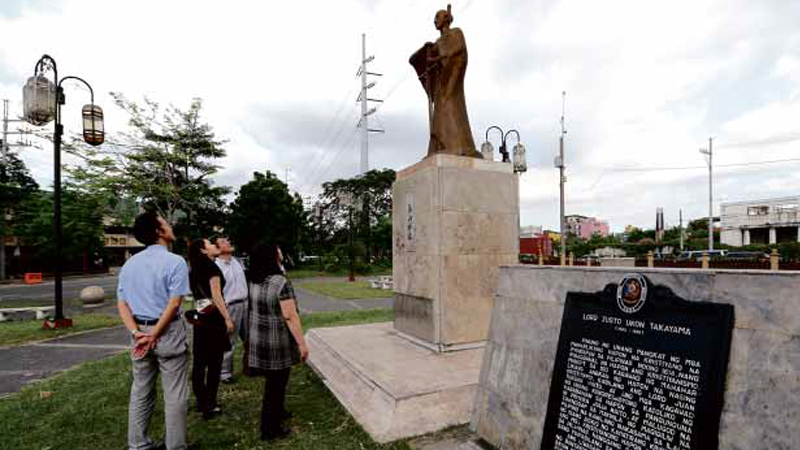Japanese ‘samurai’ who fled to PH may be made a saint

JAPANESE tourists from Nagasaki admire the statue of Japanese “samurai” Ukon “Justo” Takayama that stands at Plaza Dilao in Paco. Takayama, a Catholic, is expected to be beatified next year. RAFFY LERMA
MANILA, Philippines–A Japanese samurai who lived and died in Manila during the early 17th century may be beatified next year, CBCP News, the official news service of the Catholic Bishops Conference of the Philippines, has reported.
The CBCP said over the weekend that Japan’s Episcopal Conference had submitted to the Vatican Congregation for the Causes of Saints the documents necessary to elevate to sainthood the late Ukon “Justo” Takayama.
Dubbed “Samurai of Christ,” Takayama was born in Nara, Japan, in 1562 and raised a Roman Catholic by his convert father.
“He clung to his faith without doubts, without being swayed by any temporary wealth. He followed Jesus Christ at all times and lived a Christian life according to the Gospel,” CBCP News quoted Bishop Joseph Takami of the Catholic Diocese of Nagasaki as saying.
The Jesuits, including St. Francis Xavier, the patron saint of missionaries, were the first Christians to set up missions in Japan, arriving there in the 1500s.
Article continues after this advertisementHostility, however, against the western religion grew under the rule of Japanese shogun Toyotomi Hideyoshi, who distrusted foreigners and anything alien, kicking out the Jesuit missionaries from the country in 1587.
Article continues after this advertisement“There were no (Catholic) priests left in Japan. They were all expelled, promoting the community to go underground, keeping their faith and their prayers hidden,” the CBCP said.
Despite the ban on Christianity imposed by the Tokugawa shogunate, the Takayama family defied it.
Abandoned his wealth
Instead of abandoning their faith, Ukon Takayama “abandoned his social status, wealth and all his properties, including a castle, and was even expelled” from Japan.
Along with over 100 other Christians, he left Nagasaki on Nov. 8, 1614, and sought refuge in the Philippines.
On Dec. 21, the exiles arrived in Manila where they were “received by friendly Filipinos and lived under a common bond of Christian brotherhood.”
The group, which included Japanese lord Tukuan Naito, put up a settlement in Dilao, the old name of Manila’s Paco district.
The Japanese congregation “remained in the country until they became part of the Philippine population.”
Takayama, who adopted the Filipino name Justo, died on Feb. 3, 1615. “The then Spanish government gave him a burial worthy of a Christian and a samurai,” said CBCP News.
His statue, which shows the “honorary Filipino” in full samurai gear, has been standing since 1992 at the Philippine Friendship Park in Paco’s Plaza Dilao.
Takayama’s monument was “erected as a sign of friendship and cooperation between the Filipino and Japanese people,” according to the National Historical Institute.